Bergamot is your top choice for oriental perfume blends, offering a fresh, floral brightness that harmonizes perfectly with deep base notes. You'll also want to contemplate mandarin and sweet orange for their delectable sweetness when paired with amber. For modern twists, try yuzu's bright tartness or kumquat's sweet-tart profile against vanilla bases. Each citrus note brings unique character to your blend, and proper layering techniques will release their full potential.
Understanding Citrus Notes in Oriental Perfumery

While oriental perfumes are known for their rich, warm base notes, citrus notes play a crucial role in creating a balanced and dynamic fragrance experience.
When you're exploring oriental fragrances, you'll notice how citrus notes like bergamot, lemon, and mandarin bring brightness and freshness to these complex compositions.
What makes citrus perfumes particularly interesting in this fragrance family is their ability to create an uplifting first impression that contrasts beautifully with the deeper heart and base notes.
Though these bright notes typically last less than 30 minutes, they're key in setting the stage for the perfume's evolution.
You'll find bergamot especially prevalent in oriental fragrances, as its tart, slightly floral character perfectly complements the sweet, resinous elements that define this beloved fragrance family.
Essential Bergamot: The Crown Jewel of Citrus Top Notes
A fragrant treasure from the Mediterranean, bergamot stands as the quintessential citrus note in oriental perfumery.
You'll find this bright, complex citrus top note primarily sourced from Italy's Calabria region, where the bergamot orange tree flourishes in the warm climate.
When you're exploring oriental fragrance compositions, you'll notice how bergamot's unique blend of tart, floral, and spicy notes creates perfect harmony.
The essential oil, cold-pressed from the fruit's peel, adds a revitalizing brilliance that lifts and balances the warm, rich base notes typical of oriental scents.
Beyond its role as a masterful balancing agent, bergamot brings an uplifting quality that makes it invaluable in modern perfumery.
It's no wonder perfumers consider this versatile citrus note the crown jewel of top notes.
Mandarin and Sweet Orange Pairings With Amber

When exploring oriental fragrances, you'll discover that mandarin and sweet orange create enchanting partnerships with amber. These citrus notes bring a vibrant, juicy brightness that perfectly balances amber's deep, resinous character.
You'll find that mandarin's subtle floral undertones work especially well in this pairing, while sweet orange adds a delectable sweetness to the mix.
To make the most of these combinations, you'll need to reflect on their fleeting nature. Since citrus top notes tend to dissipate quickly, they require careful blending with amber and other base notes like vanilla and tonka bean.
When properly balanced, mandarin and sweet orange will enhance your oriental blend's complexity, creating an uplifting opening that seamlessly shifts into the warmer, richer heart of your fragrance.
Exotic Yuzu and Kumquat Combinations
When you're crafting oriental perfumes, yuzu's bright, tart aroma can cut through rich base notes while adding an unmistakable Asian sophistication to your blend.
You'll find kumquat's sweet-tart profile works beautifully with vanilla and amber, creating an intriguing balance between citrus freshness and oriental warmth.
These exotic citrus fruits work in harmony to bring both energizing top notes and complex depth to your oriental compositions, offering a contemporary twist on traditional formulations.
Unique Yuzu Blending Notes
The vibrant fusion of yuzu and kumquat creates an extraordinary top note combination that'll transform your oriental perfume blends.
You'll discover yuzu's complex aroma profile offers a perfect balance of lemon and grapefruit notes, making it an ideal choice for adding depth to your fragrances.
When you're crafting oriental perfumes, yuzu's invigorating character acts as a natural complement to warmer base notes. Its citrus notes provide a bright, uplifting contrast to rich amber and spice undertones.
By incorporating yuzu into your blends, you'll achieve a more sophisticated and multifaceted oriental fragrance.
The addition of kumquat enhances the overall composition with its unique sweet-tart profile, creating a harmonious balance that'll captivate anyone who experiences your perfume creations.
Kumquat's Sweet-Tart Balance
Building on yuzu's citrus complexity, kumquat brings its own distinctive sweet-tart personality to oriental perfume compositions.
You'll find this unique citrus scent creates an intriguing balance that enhances the depth of oriental fragrances while maintaining their sophistication.
When you're working with kumquat in top notes, you'll notice how its invigorating zesty character provides an initial burst of brightness that perfectly shifts into warmer base elements.
It's particularly effective when paired with traditional oriental ingredients like vanilla and amber, where the kumquat's sweet-tart profile helps create a more dynamic opening.
This combination makes your fragrance more versatile and appealing for different occasions, offering a modern twist on classic oriental compositions while preserving their rich, sensual character.
Asian Citrus Pairing Secrets
Combining yuzu and kumquat creates a sophisticated citrus harmony that elevates oriental perfume compositions to new heights.
When you're crafting citrus fragrances, these Asian fruits offer unique characteristics that blend seamlessly with traditional oriental bases. You'll find their fresh scents perfectly complement both floral fragrance and woody fragrance elements.
- Yuzu's grapefruit-mandarin fusion adds depth while kumquat's sweet-tart profile creates balance in your oriental blends.
- Layer these citrus notes with vanilla or amber to create a dynamic contrast between bright top notes and rich base notes.
- Experiment with different concentrations to achieve the perfect balance – start with yuzu as your dominant note and adjust kumquat to taste.
These Asian citrus combinations work exceptionally well in modern oriental compositions, offering a contemporary twist on classic perfumery.
Neroli's Role in Oriental Blends
When you're crafting oriental perfumes, neroli's bright floral-citrus notes can transform your blend by enhancing its sensual depth while maintaining freshness.
You'll find that neroli's sweet, slightly spicy character acts as a perfect bridge between light top notes and rich base notes, creating a more sophisticated and well-rounded fragrance.
Its calming aromatherapeutic properties will complement the warm, exotic elements of your oriental blend while extending the life of your citrus accords.
Neroli's Sensual Depth Enhancement
Through its bright floral-citrus character, neroli brings a remarkable balance to oriental perfumes while enhancing their sensual depth.
You'll discover how this precious essence works harmoniously with vanilla and tonka bean, creating a sophisticated interplay between fresh top notes and rich base accords. Its complex profile delivers an instant burst of freshness that gracefully shifts into warmer elements.
- Neroli's green and honeyed facets complement the sweetness in oriental compositions
- Its calming properties add a comforting dimension while maintaining an uplifting quality
- The essence's volatility makes it perfect for creating an immediate fresh impact
When you're crafting oriental blends, you'll find neroli's versatility elevates both floral and gourmand aspects, adding layers of intrigue that transform your composition into a more sophisticated creation.
Sweet-Floral Accent Properties
Neroli's sweet-floral signature transforms oriental blends by adding layers of bright, honeyed accents that dance between invigorating and sensual territories.
You'll notice how this precious essence elevates your oriental fragrances by introducing a delicate balance of sweetness and sophistication.
When you're working with oriental compositions, neroli's natural affinity for base notes of vanilla creates a seamless bridge between top and bottom layers.
The sweet note emerges gradually, complementing heavier resins while maintaining the blend's complexity.
In floral fragrances with an oriental twist, neroli acts as a harmonizing force, offering both freshness and depth.
Its volatile nature means you'll experience an initial burst of citrusy brightness that gracefully steps aside, allowing deeper elements to develop their full character over time.
Bitter Orange and Spice Harmonies
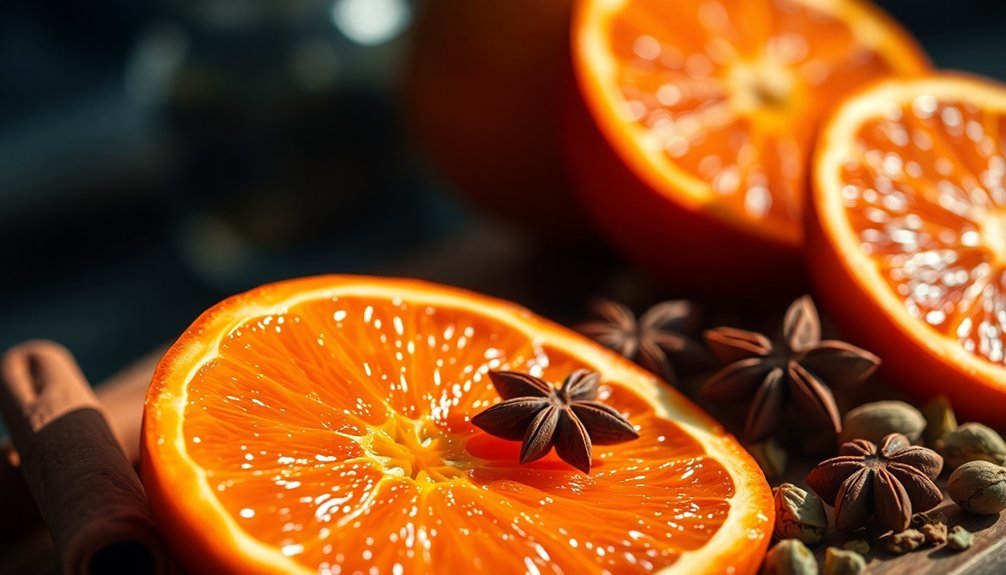
The remarkable synergy between bitter orange and warm spices creates one of perfumery's most enchanting combinations in oriental fragrances.
You'll find that bitter orange's zesty brightness perfectly balances the rich warmth of oriental perfumes while adding a lively opening to fragrance compositions. When you're crafting spice harmonies, this citrus note works exceptionally well with cinnamon and clove, creating an intriguing depth that's hard to replicate.
- Bitter orange helps cut through the heavy sweetness of vanilla and tonka bean base notes
- Its essential oil delivers uplifting qualities that energize the overall blend
- The combination evokes an exotic sensuality that's signature to oriental perfumes
These harmonious interactions make bitter orange an invaluable ingredient when you're designing sophisticated oriental fragrances that need both freshness and complexity.
Balancing Citrus With Oriental Base Notes
When crafting oriental perfumes, balancing citrus top notes with rich base notes requires a delicate touch to achieve harmony.
You'll want to carefully measure your citrus perfume notes, as their volatile nature means they'll evaporate quickly while leaving a lasting impression on your blend.
To create a well-balanced fragrance, you'll need to take into account how your citrus elements interact with oriental base notes like patchouli, myrrh, or vanilla.
These combinations can produce a complex scent that's both invigorating and sensual. The citrus acts as a bridge, softening heavy resins and spices while adding vibrancy to the overall composition.
Remember that proportion is key – too much citrus will overpower your oriental base notes, while too little won't provide enough contrast to achieve that perfect balance.
Seasonal Performance of Citrus-Oriental Blends
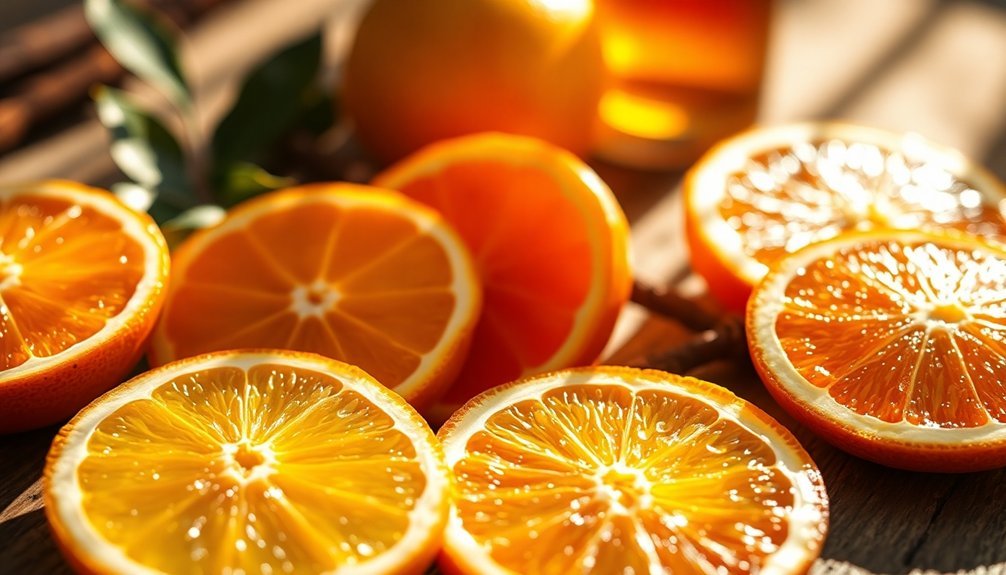
You'll find citrus-oriental fragrances perform distinctly between seasons, with the citrus notes projecting boldly in summer's heat while becoming more subdued in winter's chill.
To maximize performance year-round, you can layer your citrus-oriental scent with a complementary oriental base fragrance, ensuring the citrus remains vibrant even in cooler temperatures.
The ambient temperature greatly affects how these blends project, as warmer conditions amplify the invigorating citrus while allowing the oriental base notes to create a lasting aromatic trail throughout the day.
Summer Vs Winter Performance
Seasonal changes dramatically affect how citrus-oriental perfume blends perform on your skin.
In summer, you'll notice the citrus top notes shine brighter, creating an invigorating and rejuvenating experience that perfectly complements warm weather.
However, winter's cold temperatures can mute these lively notes, causing them to fade more quickly and making the oriental base more prominent.
- During summer months, citrus notes provide an uplifting burst that enhances the fragrance's overall vibrancy.
- Winter weather tends to dampen citrus notes, pushing the warmer oriental elements to the forefront.
- Combining citrus with deep oriental notes like vanilla or amber creates a balanced blend that works year-round.
To get the best performance across seasons, you'll want to reflect on how temperature affects your fragrance's projection and longevity, adjusting your application accordingly.
Layering For Extended Wear
Although citrus notes are naturally ephemeral, strategic layering can considerably extend their presence in oriental perfume blends.
You'll find that applying a citrus-scented body lotion before your oriental fragrance creates a solid foundation that helps anchor the volatile top notes while enhancing the overall projection.
When you're layering citrus with oriental elements, you're creating a complex fragrance journey that evolves throughout the day.
The bright, zesty opening notes will gradually fade into warm, sweet base notes, but the initial preparation helps maintain their presence longer.
For maximum longevity, start with moisturized skin, apply your citrus-based lotion, and then follow with your oriental perfume.
This technique works especially well during warmer months when the heat naturally amplifies both the fresh citrus and rich oriental notes.
Temperature Impact On Projection
Temperature plays an essential role in how citrus-oriental blends project throughout different seasons.
You'll notice your fragrance performs differently as the weather changes, with warmer conditions amplifying the citrus notes' projection while making them dissipate faster. In cooler temperatures, you'll experience a more subtle citrus opening, but the oriental base notes will shine through with greater prominence.
- Warm weather enhances the initial burst of citrus, creating a stronger projection but shorter longevity
- High humidity helps diffuse citrus notes more effectively, making them especially invigorating in tropical conditions
- Cold temperatures subdue citrus projection but allow oriental base notes to emerge more prominently
Consider these temperature effects when choosing your fragrance concentration and application method to achieve ideal projection throughout the year.
Citrus Extraction Methods for Top Notes
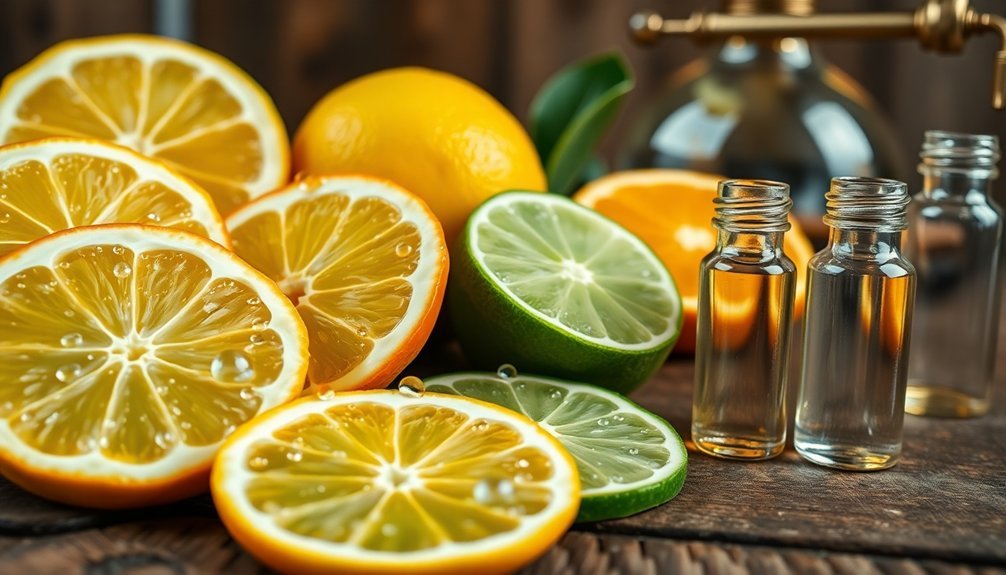
The artful extraction of citrus oils demands specific methods to capture their bright, effervescent qualities for oriental perfume compositions.
You'll find three primary citrus extraction methods that shape the character of your fragrances.
Cold pressing leads the way for most citrus essential oils, extracting vibrant notes from orange and lemon peels that'll give your blend an authentic, zesty lift.
When you're working with delicate orange blossom and other floral elements, steam distillation proves invaluable, preserving both citrus and floral nuances.
For the most fragile blossoms, solvent extraction offers a gentler approach, yielding richer, more complex aromatic profiles without heat damage.
Each method considerably influences how your citrus top notes will perform in oriental compositions, affecting both their initial impact and how they interact with deeper base notes.
Tangerine and Blood Orange Variations
Building on our extraction methods, two citrus variations stand out for their distinctive contributions to oriental perfumes: tangerine and blood orange.
You'll find tangerine's sweet-tart profile creates an uplifting brightness, while blood orange delivers a deeper, more complex character that pairs beautifully with amber and vanilla in oriental blends.
- Tangerine adds a light, sparkling freshness that cuts through heavier base notes
- Blood orange introduces a rich, juicy dimension that enhances warmth
- Both citrus notes create an engaging initial impression due to their high volatility
When you're crafting oriental blends, these citrus variations help balance the signature sweetness while adding vibrancy.
You'll notice how they transform traditional oriental compositions into more dynamic, contemporary interpretations that captivate from the first spritz.
Modern Citrus Notes in Classic Oriental Formulas
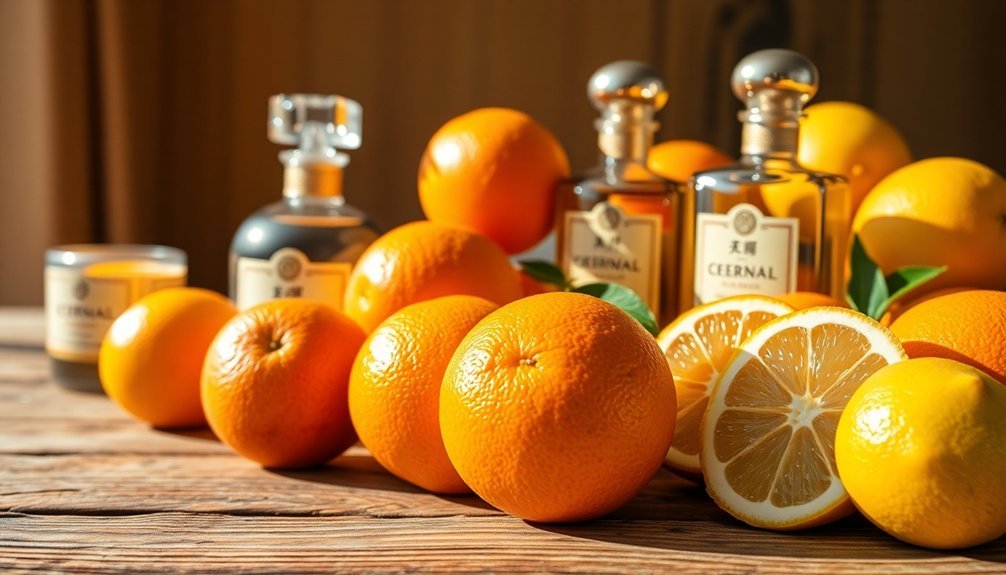
Contemporary perfumers have revolutionized classic oriental formulas by introducing bright citrus notes that breathe new life into traditional compositions.
You'll find bergamot leading the charge, adding sophistication with its tart, floral character that perfectly complements the warm base notes of oriental fragrances.
Mandarin's sweet, playful profile offers another modern twist, creating balance within rich, sensual blends.
When you're exploring these contemporary interpretations, you'll notice how lemon and lime accents can deliver invigorating freshness without compromising the signature warmth of oriental scents.
The marriage of citrus top notes with classic oriental ingredients like vanilla and tonka bean results in a dynamic fragrance experience.
These modern adaptations expand the appeal of oriental perfumes while maintaining their luxurious, complex character.
Creating Signature Oriental-Citrus Accords
When developing your signature oriental-citrus accord, mastering the delicate balance between bright top notes and rich base elements becomes essential.
You'll need to experiment with different citrus varieties while considering how they interact with your oriental base notes. Try combining fresh bergamot or mandarin with spicy cardamom to create complexity, or pair zesty lemon with warm vanilla for a modern twist.
- Blend multiple citrus notes with varying intensities to create depth and prevent your fragrance from becoming one-dimensional.
- Layer your citrus elements with anchoring base notes like patchouli or myrrh to extend longevity.
- Test your combinations in different concentrations to find the perfect balance between invigorating top notes and rich oriental components.
This experimental approach will help you develop unique, harmonious accords that capture both vibrancy and warmth.
Frequently Asked Questions
What Are the Oriental Fragrance Notes?
You'll find oriental fragrances feature warm, rich notes like vanilla, tonka bean, myrrh, frankincense, and various resins. These sweet and spicy elements create depth, while amber notes add complexity to the blend.
What Notes Are in Citrus Perfume?
You'll find bright, zesty notes in citrus perfumes including orange, lemon, lime, bergamot, and mandarin. These fruits create invigorating top notes, while neroli adds a sweet-bitter touch to your fragrance experience.
What Pairs Well With Citrus Scents?
You'll find citrus scents pair beautifully with warm spices like cinnamon and cardamom, sweet notes like vanilla and tonka bean, aromatic herbs, floral elements, and woody bases. They're especially great with jasmine and patchouli.
What Is the Best Citrus Fragrance?
You'll find bergamot is widely considered the best citrus fragrance, as it offers a perfect balance of tart and floral notes. It's versatile enough to work in many perfume compositions and fragrance applications.
In Summary
You've learned how citrus top notes can transform oriental perfumes from heavy and mysterious to bright and inviting. Whether you're working with classic bergamot, exotic yuzu, or sweet mandarin, these effervescent notes add sparkle and dimension to your oriental blends. Don't be afraid to experiment with different citrus combinations and extraction methods – they'll help you create unique signature fragrances that bridge tradition and innovation.

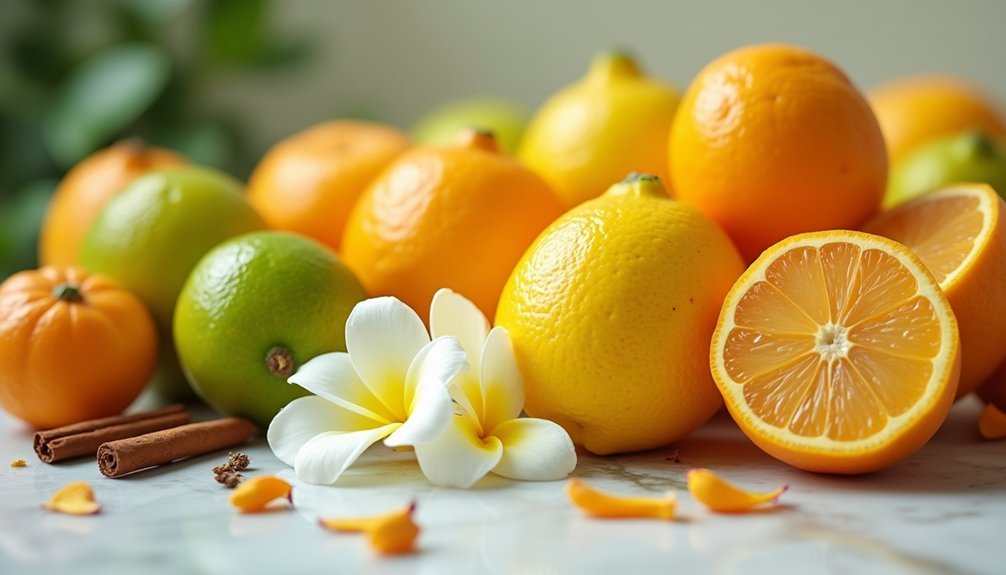



Leave a Reply